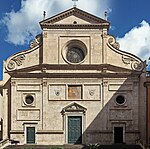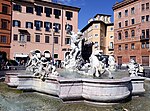Ludovisi Battle sarcophagus

The Ludovisi Battle sarcophagus or "Great" Ludovisi sarcophagus is an ancient Roman sarcophagus dating to around AD 250–260, found in 1621 in the Vigna Bernusconi, a tomb near the Porta Tiburtina. It is also known as the Via Tiburtina Sarcophagus, though other sarcophagi have been found there. It is known for its densely populated, anti-classical composition of "writhing and highly emotive" Romans and Goths, and is an example of the battle scenes favored in Roman art during the Crisis of the Third Century. Discovered in 1621 and named for its first modern owner, Ludovico Ludovisi, the sarcophagus is now displayed at the Palazzo Altemps in Rome, part of the National Museum of Rome as of 1901.The sarcophagus is a late outlier in a group of about twenty-five late Roman battle sarcophagi, the others all apparently dating to 170–210, made in Rome or in some cases Athens. These derive from Hellenistic monuments from Pergamon in Asia Minor showing Pergamene victories over the Gauls, and were all presumably commissioned for military commanders. The Portonaccio sarcophagus is the best known and most elaborate of the main Antonine group and shows both considerable similarities to the Great Ludovisi sarcophagus, and a considerable contrast in style and mood.
Excerpt from the Wikipedia article Ludovisi Battle sarcophagus (License: CC BY-SA 3.0, Authors, Images).Ludovisi Battle sarcophagus
Piazza di Sant'Apollinare, Rome Municipio Roma I
Geographical coordinates (GPS) Address Phone number Website Nearby Places Show on map
Geographical coordinates (GPS)
| Latitude | Longitude |
|---|---|
| N 41.901194 ° | E 12.472833 ° |
Address
Museo Nazionale Romano
Piazza di Sant'Apollinare 46
00186 Rome, Municipio Roma I
Lazio, Italy
Open on Google Maps










